The unlikely bond of Kevin Garnett and Gino originally appeared on NBC Sports Boston
To the uninitiated, it’s a curious photograph.
Kevin Garnett, perched alone at the end of the Boston Celtics bench, with his right arm extended towards the video board where a man in black bellbottom jeans and a form-fitting Gino Vannelli T-shirt dances on the screen. The background is filled up with Boston’s championship banners and there’s an open spot among the retired numbers where Garnett’s No. 5 will soon join.
But no snapshot better encapsulates Garnett’s mesmerizing six-year run in Boston, one that saw him restore a championship culture to the NBA’s most decorated franchise while ending a 22-year title drought. It captures a man best known for his impossible-to-match intensity allowing himself to lower his guard only with victory firmly secured.
A look back at Kevin Garnett's final game at TD Garden
Get Boston local news, weather forecasts, lifestyle and entertainment stories to your inbox. Sign up for NBC Boston’s newsletters.
For more than a decade before Garnett’s arrival, the Celtics celebrated lopsided wins by running an American Bandstand mashup highlighted by the bearded man with impossibly slick dance moves. But Gino only became a phenomenon after Garnett’s arrival and Boston’s home-court dominance made it the modern version of Red Auerbach’s victory cigar.
"KG loved Gino because it meant we kicked someone's ass,” said teammate Brian Scalabrine. "The man loved winning more than anything in the world. The fact that he got to sit on the sidelines, watch the crowd go nuts -- that's his thing.”
A jumbo-sized version of the photograph adorned a wall inside the Celtics’ executive offices next to TD Garden, a personal favorite of an ownership group that named itself “Banner 17 LLC” upon purchasing the franchise and then made that name a reality less than a year after acquiring Garnett in the summer of 2007.
The Celtics will retire Garnett’s No. 5 on Sunday, his digit taking its spot alongside teammate Paul Pierce in the rafters at TD Garden and now mingling on the same fabric that displays Larry Bird’s No. 33.
But Garnett already had a spot above the parquet. Because he is impossibly tied to the Gino clip that still rolls to celebrate Boston’s biggest victories.
——
Gino and Garnett entered the league in the same year.
Just months after the Timberwolves made Garnett the No. 5 pick out of high school in the 1995 NBA Draft, the Celtics shuffled into the $120 million FleetCenter and, for the first time in team history, had a gigantic video board they needed to fill with content during timeouts.
That year, John Mitchell, the building's director of audio/video control room, and some co-workers were out on nearby Canal Street when they were drawn to televisions showing episodes of the long-running dance program, "American Bandstand.” A bearded man with impossibly springy limbs repeatedly caught their attention. Mitchell wanted the clips for the Jumbotron.
An assistant was tasked with recording roughly 20 hours of American Bandstand clips during one of the all-day marathons that routinely ran on cable music station, VH1. Mitchell then pored through the footage to find any clips of the Gino-shirted dancer and inter-spliced those scenes among other highlights from the recording. The Bee Gees’ “You Should Be Dancing” was layered over the tape to create a sequenced designed to get fans moving during in-game timeouts, even if the video quality left something to be desired.
"The original footage was not that great because we had to record it in VHS extended-play mode to get as much as we could on each VHS tape,” Mitchell said. "It was made to be just another interactive dance video that we would run in the fourth quarter during hot timeouts.”
In its infancy, the Gino clip was simply one tape fighting for fan attention among early arena standards (think: the "Shout” clip from Animal House, or Cab Calloway leading the call-and-response section of “Minnie the Moocher” from The Blues Brothers). But one man set it apart.
"In the spring of 1996, we started running it only in the last timeout if we were sure the Celtics would win,” Mitchell said. “First, it was just a control room thing but soon we would hear fans yelling, ‘Gino!’ when we ran it."
Considering the Celtics won only 18 home games that season, and only eight were by double digits, Gino appearances were infrequent at best and essentially only an amusement to staffers and diehards in an otherwise forgettable 33-win campaign.
But the clip had enough of a cult following that, by the end of that season, the tape was labeled “Gino" and stashed for future use.
Said Mitchell: "The rest is Jumbotron history.”
——
Garnett is best known for his unwavering intensity. Everyone that came in contact with him during his NBA career marveled at his inability to downshift — most famously when Doc Rivers was forced to end an off-day practice early because Garnett, who was supposed to be resting, wouldn’t stop sprinting up and down the sideline while mimicking the action on the court (all while trash-talking Rivers as he did).
Scalabrine likes to tell the story of how Garnett would be cackling while watching his beloved “Family Guy” episodes in the cramped trainer’s room inside the Celtics' locker room at TD Garden. But in the crawl to tip-off, Garnett would shift to game mode -- culminating with him headbutting the stanchion and emphatically pounding his chest before tip -- and anyone that didn’t do the same was risking his wrath.
Which is why it was so jarring to see Garnett completely disarmed whenever the Gino clip ran.
During his final visit to Boston as a player with the Minnesota Timberwolves in December 2015, then-39-year-old Garnett remained stoic despite repeated, “We want KG!” chants from the Garden faithful. Then, with Boston up big late in the game, the throbbing baseline from “You Should Be Dancing” started and Garnett lit up like a Christmas tree.
All this, while his Minnesota Timberwolves teammates looked on baffled by what had prompted the shift.
"My teammates were looking at me like, ‘What is this?’ I was like, ‘I’ll explain later,’” said Garnett.
Explaining Gino to the uninformed was practically Garnett's rite of passage. Legendary Celtics broadcaster Tommy Heinsohn delighted in watching Garnett drag a new teammate to the end of the Boston bench and attempt to explain why everyone was so giddy.
Garnett would often be too excited to even make sense and a rookie would just stare in confusion as Garnett and Pierce mimicked the moves on the screen.
Then, when Gino appeared, Garnett’s right arm would extend skyward.
When the Celtics upgraded their American Bandstand footage and added new Gino clips to the highlight package in 2009, Garnett excitedly asked reporters after the game, "Did y'all check out that new Gino footage?"
In 2013, after being dealt to the Nets, the Celtics ran an in-game tribute during Garnett’s first game back in Boston that culminated with the iconic image of him pointing to Gino. When the Bee Gees started playing, Garnett, who had kept his head buried throughout the 90-second tribute, finally looked skyward. He was disappointed it was just the still image.
"Listen, I was so upset I didn't even get the really deep Gino in my system,” Garnett said. "My low moment for the night, you know what I mean? Gino is a big part of me and I didn't even get to celebrate it. I'm still a huge Gino fan.”
——
Between the fall of 1995 and spring of 2007, the Celtics went 240-236 during regular season home games at TD Garden. Only 107 of those wins were by double digits. You essentially had a better chance of catching Gino on a VH1 rerun than you did on your Garden visit.
Then Garnett arrived. The Celtics went 35-6 at home during his first season. Boston won 26 games by double digits, including 15 by 20 points or more. Gino went from occasional visit to having a residency above the parquet. And he quickly endeared himself to Garnett.
Former vice president of live events Sean Sullivan said the hardest decision was when to trigger the Gino clip. Fans would clamor for it from the start of the fourth quarter of lopsided games but, run it too soon, and the coaching staff would be shooting him daggers at the scorer’s table.
All these years later, the Celtics have never been burned by running the clip too soon. They’ve had to play it safe a few times, never wanting to risk fueling an opposing team’s late-game comeback. Boston's cheerleaders, in handcrafted Gino t-shirts, would often wait huddled in a tunnel near the Garden floor to see if they would join the nightly disco party. Even Garnett would look skyward at times and lament the lack of the clip running despite a modest lead.
When the clip hit, the Garden turned into Studio 54. Or maybe Studio 5 is the better offshoot in this case.
At the height of the Gino phenomenon, during the 2008 playoffs, Celtics staffers pondered the possibility of trying to hunt down the real Gino with the possibility of an in-game visit. Sullivan and his team were immediately skeptical about such a pursuit.
"We kinda wanted to leave the myth right where it was,” Sullivan said.
NBC Sports
Once word filtered to Garnett, he made it clear he didn’t want the team to pursue it, either.
"KG definitely did not want the legend of Gino to be disturbed in any way,” said Celtics team president Rich Gotham.
The Wall Street Journal, however, launched their own hunt with help from Dick Clark Productions, who produced American Bandstand. They located a redheaded woman seen dancing alongside Gino and she detailed how she lent the man her Vannelli t-shirt (which helps explain the snug fit). She made some calls trying to help track down the real-life Gino, a man named Joseph R. Massoni, only to discover he passed away from pneumonia in 1990 at the age of 34.
There were thoughts of retiring the Gino clip after the 2008 title season. With the support of the events staff, it has persevered, even after Garnett’s departure. And it seems a fair bet that it will find its way into Sunday’s proceedings.
The modern Celtics, of course, could do their part and win a lopsided game against the Mavericks to ensure Garnett sees it at least once.
But Gino needs to be part of the ceremony. You can’t tell the story of Garnett’s time in Boston and his legacy here without including Gino. They are forever linked. And now they’ll forever dance together above the Garden parquet.
And now whenever Boston players look skyward to see Gino grooving, they’ll see Garnett’s No. 5 nearby, too.



